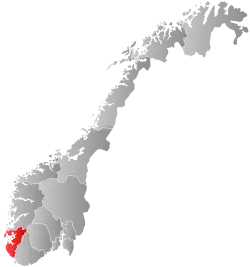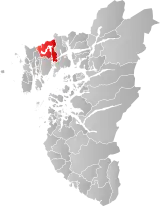Skjold Municipality
Skjold herred | |
|---|---|
 View of the Skjold area | |
 Rogaland within Norway | |
 Skjold within Rogaland | |
| Coordinates: 59°30′09″N 05°35′12″E / 59.50250°N 5.58667°E | |
| Country | Norway |
| County | Rogaland |
| District | Haugaland |
| Established | 1 Jan 1838 |
| • Created as | Formannskapsdistrikt |
| Disestablished | 1 Jan 1965 |
| • Succeeded by | Vindafjord and Tysvær municipalities |
| Administrative centre | Skjold |
| Area (upon dissolution) | |
| • Total | 172 km2 (66 sq mi) |
| Population (1965) | |
| • Total | 2,395 |
| • Density | 14/km2 (36/sq mi) |
| Demonym | Skjoldabu[1] |
| Time zone | UTC+01:00 (CET) |
| • Summer (DST) | UTC+02:00 (CEST) |
| ISO 3166 code | NO-1154[2] |
Skjold is a former municipality in Rogaland county, Norway. The 172-square-kilometre (66 sq mi) municipality encompassed all the area surrounding the Grindafjorden and Skjoldafjorden. The area is located in the present-day municipalities of Vindafjord and Tysvær. The administrative centre of the municipality was the village of Skjold where the Skjold Church is located.[3]
History
The parish of Skjold was established as a municipality on 1 January 1838 (see formannskapsdistrikt law). In 1849, the southwestern half of Skjold (population: 2,058) was separated to form the new municipality of Tysvær, leaving Skjold with 3,439 residents. In 1891, the eastern district of Skjold (population: 1,095) was separated to form the new municipality of Vats, leaving Skjold with 1,961 residents. On 1 January 1964, a small part of northern Skjold located north of the Ålfjorden (population: 24) was transferred to Sveio municipality in Hordaland county.[4]
On 1 January 1965, the municipality of Skjold was dissolved based on recommendations to the government of Norway by the Schei Committee. The districts of Liarheim and Langeland (population: 1,262), mostly located north and east of the Grindafjorden, were merged with the municipality of Sandeid and parts of the municipalities of Imsland, Vats, and Vikedal to create the new municipality of Vindafjord. The districts Dueland, Grinde, and Yrkje (population: 1,133), mostly located south and west of the Grindafjorden and Skjoldafjorden, were merged with the municipalities of Tysvær and Nedstrand and parts of the municipalities of Avaldsnes, Vats, and Vikedal to form the new, larger municipality of Tysvær.[4]
Name
The municipality (originally the parish) is named after the old Skjold farm (Old Norse: Skjǫldr) since the first Skjold Church was built there. The name is identical to the word skjǫldr which means "shield".[5][3]
Government
While it existed, this municipality was responsible for primary education (through 10th grade), outpatient health services, senior citizen services, unemployment, social services, zoning, economic development, and municipal roads. During its existence, this municipality was governed by a municipal council of directly elected representatives. The mayor was indirectly elected by a vote of the municipal council.[6]
Municipal council
The municipal council (Herredsstyre) of Skjold was made up of 17 representatives that were elected to four year terms. The party breakdown of the final municipal council was as follows:
| Party name (in Norwegian) | Number of representatives | |
|---|---|---|
| Labour Party (Arbeiderpartiet) | 3 | |
| Local List(s) (Lokale lister) | 14 | |
| Total number of members: | 17 | |
| Party name (in Norwegian) | Number of representatives | |
|---|---|---|
| Labour Party (Arbeiderpartiet) | 2 | |
| Local List(s) (Lokale lister) | 15 | |
| Total number of members: | 17 | |
| Party name (in Norwegian) | Number of representatives | |
|---|---|---|
| Local List(s) (Lokale lister) | 17 | |
| Total number of members: | 17 | |
| Party name (in Norwegian) | Number of representatives | |
|---|---|---|
| List of workers, fishermen, and small farmholders (Arbeidere, fiskere, småbrukere liste) | 1 | |
| Local List(s) (Lokale lister) | 15 | |
| Total number of members: | 16 | |
| Party name (in Norwegian) | Number of representatives | |
|---|---|---|
| Local List(s) (Lokale lister) | 16 | |
| Total number of members: | 16 | |
| Party name (in Norwegian) | Number of representatives | |
|---|---|---|
| List of workers, fishermen, and small farmholders (Arbeidere, fiskere, småbrukere liste) | 2 | |
| Local List(s) (Lokale lister) | 14 | |
| Total number of members: | 16 | |
| Party name (in Norwegian) | Number of representatives | |
|---|---|---|
| Local List(s) (Lokale lister) | 16 | |
| Total number of members: | 16 | |
| Note: Due to the German occupation of Norway during World War II, no elections were held for new municipal councils until after the war ended in 1945. | ||
See also
References
- ↑ "Navn på steder og personer: Innbyggjarnamn" (in Norwegian). Språkrådet.
- ↑ Bolstad, Erik; Thorsnæs, Geir, eds. (26 January 2023). "Kommunenummer". Store norske leksikon (in Norwegian). Kunnskapsforlaget.
- 1 2 Store norske leksikon. "Skjold – tidligere kommune" (in Norwegian). Retrieved 19 July 2015.
- 1 2 Jukvam, Dag (1999). Historisk oversikt over endringer i kommune- og fylkesinndelingen (PDF) (in Norwegian). Statistisk sentralbyrå. ISBN 9788253746845.
- ↑ Rygh, Oluf (1915). Norske gaardnavne: Stavanger amt (in Norwegian) (10 ed.). Kristiania, Norge: W. C. Fabritius & sønners bogtrikkeri. p. 443.
- ↑ Hansen, Tore; Vabo, Signy Irene, eds. (20 September 2022). "kommunestyre". Store norske leksikon (in Norwegian). Kunnskapsforlaget. Retrieved 1 January 2023.
- ↑ "Kommunevalgene 1963" (PDF) (in Norwegian). Oslo: Statistisk sentralbyrå. 1964. Retrieved 31 July 2020.
- ↑ "Kommunevalgene og Ordførervalgene 1959" (PDF) (in Norwegian). Oslo: Statistisk sentralbyrå. 1960. Retrieved 31 July 2020.
- ↑ "Kommunevalgene og Ordførervalgene 1955" (PDF) (in Norwegian). Oslo: Statistisk sentralbyrå. 1957. Retrieved 31 July 2020.
- ↑ "Kommunevalgene og Ordførervalgene 1951" (PDF) (in Norwegian). Oslo: Statistisk sentralbyrå. 1952. Retrieved 31 July 2020.
- ↑ "Kommunevalgene og Ordførervalgene 1947" (PDF) (in Norwegian). Oslo: Statistisk sentralbyrå. 1948. Retrieved 31 July 2020.
- ↑ "Kommunevalgene og Ordførervalgene 1945" (PDF) (in Norwegian). Oslo: Statistisk sentralbyrå. 1947. Retrieved 31 July 2020.
- ↑ "Kommunevalgene og Ordførervalgene 1937" (PDF) (in Norwegian). Oslo: Statistisk sentralbyrå. 1938. Retrieved 31 July 2020.
